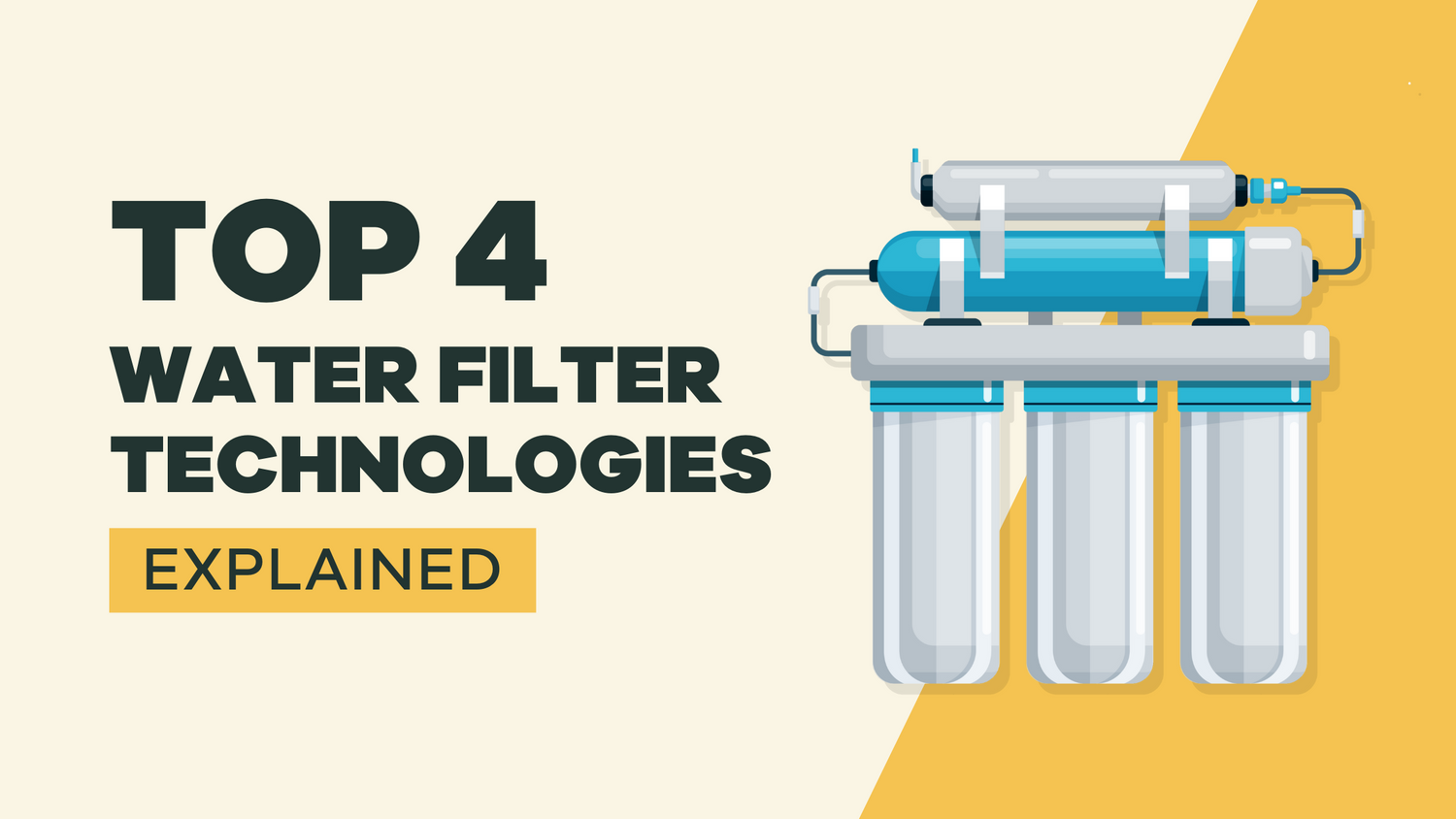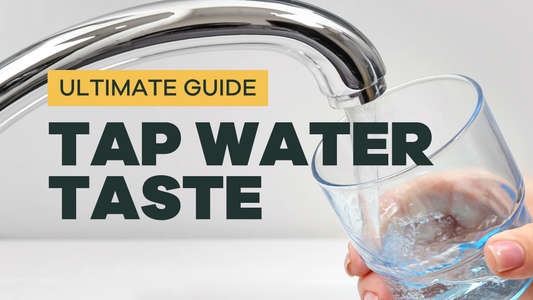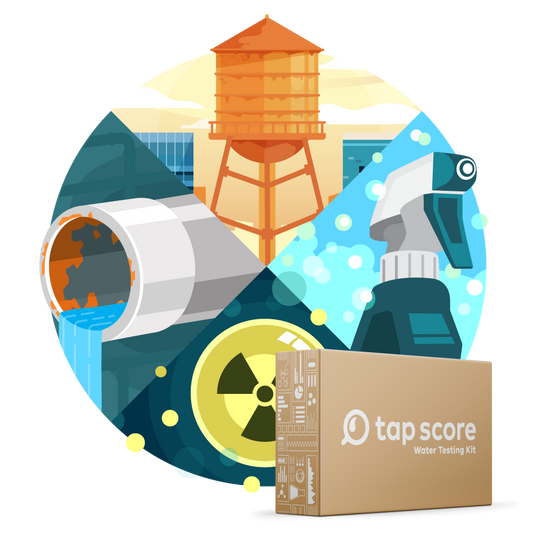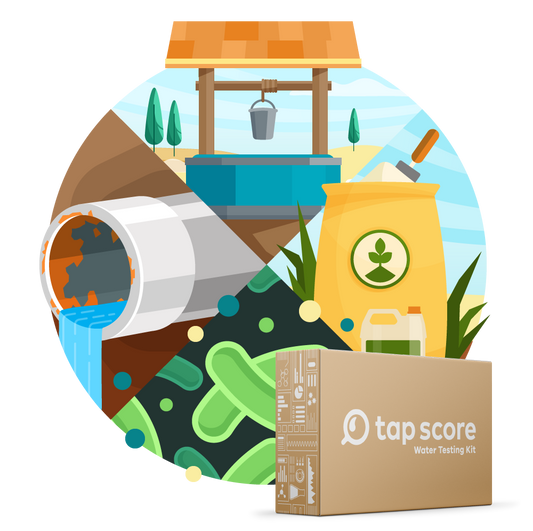
The Top 4 Home Water Filter Technologies Explained
Our blog is written by real experts— not AI. Each guide is carefully reviewed and updated based on the latest research. Plus, with no affiliate links, you can count on unbiased insights you can trust.
Whether your water comes from a private well or a municipal water utility, home water filter systems can reduce and even remove different pollutants from your water. But with so many different technologies available, choosing the right filter can be overwhelming. After all, what’s the point of investing in a filter that doesn’t address your particular needs?
We’ve prepared this short introduction to the technologies used in common home water filter systems — membrane filters, ion exchange, adsorptive media filters, and disinfection — to help answer three important questions: What kind of filters are there, how do they work, and, which filter is the best home water filter for you?
Table of Contents:
Key Takeaways:
- Membrane filters use high pressure to push water through pores that are too small to allow certain contaminants to pass through. They are expensive but remove the widest range of contaminants.
- Ion exchange filters contain resin beads with charged ions attached to their surface, exchanging unwanted ions in the water with harmless ones. Effective for a wide variety of compounds, including hardness minerals; can be maintenance-intensive.
- Adsorptive media filters remove contaminants by adsorbing (or binding) specific substances onto their surface. Cost effective but with the shortest lifespan between filter changes.
- Disinfection addresses microbial risks only and should be considered where bacteria and other microorganisms have been detected.
- Laboratory water tests provide a detailed picture of your water quality so you know what you need to treat in order to decide which treatment technology will be right for you.
Technologies in Common Water Filter Systems
Home water filter systems utilize four primary technologies (excluding pre-filtration):
Pre-filtration
Pre-filtration or pre-treatment is the removal of certain contaminants from water before it is to be treated by a more complex filtration system, such as membrane filtration or ion exchange. This is typically to help boost efficiency and protect the longevity of more complex filtration systems.
-
Sediment Filters:
Essential for well owners, sediment filters trap suspended solids such as sand, silt, loose gravel, scale, clay, and other organic material that can contaminate untreated surface and ground water as it passes through a well system.
Membrane Filtration
Membrane filters use high pressure to push water through a membrane with small holes — called pores — that are too small to allow certain contaminants to pass through.
The effectiveness of membrane filters in reducing the concentrations of particular contaminants depends on the size of the pores. Pore sizes range from 0.1 micron to 0.0001 micron. For reference, the average human hair is around 100 microns in diameter. Contaminants like PFAS and microplastics range from less than 0.1 microns to 10 microns.
The following are notable household membrane filter systems:
-
Reverse Osmosis (RO):
RO systems use a high pressure pump to push water through a series of membranes. Reverse osmosis membranes have the smallest pores and thus remove the widest variety of contaminants from water, down to single ions.RO systems can be either point-of-use (POU) or point-of-entry (POE), POU is more common
-
Micro-, Ultra-, and Nanofiltration:
These filters are similar to RO but have larger pore sizes. Pore sizes are largest in microfiltration and decrease to ultra- and then nanofiltration. As pores decrease in size, the contaminants that are successfully removed get progressively smaller. Microfiltration, for example, only removes large contaminants like turbidity and protozoa; it is not effective at removing chemicals. Nanofiltration, on the other hand, is effective at removing contaminants as small as single compounds.
Micro-, ultra-, and nanofiltration systems can be either POU or POE
What Is the Difference Between Reverse Osmosis and Nanofiltration?
RO systems have the smallest pore size. They will remove single ions, whereas nanofiltration removes single compounds but not single ions.
Is Reverse Osmosis the Best Type of Filtration?
Reverse osmosis (RO) is effective in reducing a wide variety of contaminants, but whether or not it's the best type of filtration system really depends on the specific contaminants you’re trying to remove and some of your own preferences.
RO is great for things like dissolved salts that are difficult to remove otherwise, and it also removes most other dissolved contaminants like metals and organics (e.g., pesticides, PFAS, etc.). If you are trying to remove a lot of different contaminants that, on their own, require different treatment technologies but would all be removed by RO, then it is your best option. Or if you’re trying to remove dissolved salts that are tough to remove by other means, RO may also be your best option.
However, RO is best applied at the point of use (so your faucet), not at the point-of-entry. RO is also expensive and may be overkill if you’re just looking to improve the taste and odor of your water, for example, which is easily done by filtration with activated carbon and is much cheaper than RO.
Pros and Cons of Membrane Filters:
- Extremely effective at removing contaminants; the smaller the pore size, the greater the effectiveness, providing you the highest level of contaminant removal outside of distillation
- Relatively easy to maintain (membrane replacement required about once a year, depending on how contaminated the source water is)
- RO systems are notably expensive to install
- RO systems produce a large stream of waste to produce a small quantity of purified water, which will impact your water costs
- RO systems might require re-mineralization to return vital minerals like potassium, calcium, and magnesium to your purified water
- Require a pre-filtration system to protect the membranes themselves from scaling and fouling
Ion Exchange (IX)
Ion exchange filters contain beads made of a resin that have ions attached to their surface. As contaminated water passes by, the ions on these beads are exchanged for unwanted ions in the water. Salts and minerals are common ions in water.
IX filters are typically POE systems
There are two types of ion exchange:
-
Anion Exchange:
Anion exchange relies on positively charged ions attached to the resin beads that attract/target negatively charged ions (anions). Common anions targeted by anion exchange filters include fluoride and arsenic.
-
Cation Exchange:
Cation exchange relies on negatively charged ions attached to the resin beads that attract/target positively charged ions (cations). Depending on your settings, cation exchange can target a variety of positively charged ions including various metals and minerals.
-
- Water Softeners: A type of cation exchange, water softeners specifically exchange hardness-causing ions like calcium and magnesium for sodium or potassium ions. Hardness is reduced because the calcium and magnesium are now stuck to the resin beads.
Pros and Cons of Ion Exchange:
- Can remove a wide range of contaminants, including heavy metals, nitrates, and hardness-causing minerals
- Can be tuned to target specific contaminants
- Can remove certain contaminants that are difficult to remove via other technologies
- Can be costly to install and maintain
- Require frequent resin regeneration cycles
- Not suitable for water with non-ionic contaminants, like certain chemicals or high levels of organic matter
Adsorptive Media Filters
Adsorptive media filters remove contaminants by using materials that can adsorb (or bind) specific substances onto their surface. These filters are designed to target and capture a wide range of pollutants depending on the filter media, including heavy metals, organic compounds, and other impurities. Contaminant levels play a direct role in how long the filter will remain effective.
Adsorptive media filters — particularly activated carbon — are highly versatile and used in common POU devices like pitcher filters, as well as in whole-home POE systems as pretreatment.
The following are common adsorptive media filter types:
Activated Carbon
Activated carbon filters are made out of tiny pieces of treated carbon in granular or block form. As water flows through active carbon filters, impurities in the water stick to the carbon and cleaner water results. It is important to note, though, that much of the effectiveness of carbon filters depends on both the flow and temperature of the water: slower flows and lower temperatures result in better filtration.
-
Granular Activated Carbon (GAC):
GAC consists of loose granules of activated carbon, resembling coarse black sand or small pellets, which provides a large surface area for adsorption but is less dense compared to the solid block form, allowing for easier flow of fluids through the filter.
-
Carbon Block:
The carbon in these filters is powdered and then compressed into a dense, solid form, providing a high surface area for adsorption. Due to their solid structure, carbon block filters generally have a higher adsorption efficiency and can remove smaller particles and lower concentrations of contaminants more effectively.
Activated carbon can be either POE or POU (but most often as pitcher and countertop filter)
-
Catalytic Carbon:
Catalytic carbon is activated carbon that is treated to enhance its ability to catalyze specific chemical reactions. This treatment can involve modifications to its surface chemistry to increase its reactivity with certain contaminants — typically chlorine, chloramine, and hydrogen sulfide (H2S). Often in the form of a block, catalytic carbon filters adsorb impurities and catalyze reactions that break these contaminants down into harmless substances.
Catalytic carbon can be either POE or POU (typically as under sink)
Activated Alumina
Activated alumina is a highly porous form of aluminum oxide (Al₂O₃). Activated alumina filters use a bed of activated alumina granules to adsorb impurities as water passes through them, including fluoride, arsenic, selenium, and other heavy metals.
Activated alumina can be either POE or POU
Pros & Cons of Absorptive Media Filters:
- Adsorptive media filters include the most common and cost-effective filters on the market (like pitcher and faucet filters)
- Are quite effective at a wide range of contaminants; manufacturers often make different levels of filters that allow you some customizability
- Generally easiest to use and maintain
- Typically improve water’s taste and odor
- Depending on usage and contamination levels of untreated water, more frequent filter changes can become necessary
- Flow rate and temperature sensitivity
Disinfection Technologies
Disinfection addresses microbial risks only and should be considered where bacteria and other microorganisms have been detected. Simply put, disinfection involves a chemical or physical process that results in the destruction or inactivation of microorganisms.
Disinfection technologies are typically implemented as POE systems
There are two chief disinfection technologies and a couple of other common practices:
-
Chlorination:
Chlorine can be used as a continuous drip or in large doses at one time, called “shock chlorination.” Shock chlorination, for example, is the recommended approach for well owners with coliform or E. coli detected in their annual water test.
Continuous chlorination involves adding chlorine to water in an ongoing fashion so that the water is always chlorinated, much like water that comes from utilities.
What You Need to Know About Chlorine and Chloramine
-
Ultraviolet (UV):
UV disinfection technology works by killing bacteria, viruses and parasites with UV light. It is typically installed as the final stage in a treatment system since particles can impact performance so they are removed by earlier stages.
Additional Disinfection Technologies:
-
Distillation:
Distilled water is a type of purified water that has been boiled in a controlled setting until it evaporates. The water vapor is then condensed back into liquid form, leaving the water devoid of all impurities. Because it has been purified of everything, including vital minerals, distilled water is not usually used for drinking and is often used in a variety of laboratory, industrial, and mechanical settings.
-
Boiling:
Boiling water in a kettle or on the stovetop will disinfect the water, but may make other issues worse by concentrating contaminants that do not boil off (like nitrate).
Is Boiled Water Pure? Safe Water Guide
Pros & Cons of Disinfection Technologies:
- Disinfection technologies are indispensable for those who do not get their water from a public water system. That means well owners, or those who collect rainwater or spring water.
-
Disinfection technologies solely address microbial risks and are not helpful at removing or reducing other contaminants*. They should be used in conjunction with other filtration technologies to address other contaminants.
* Distillation is effective at removing ALL impurities from water — including beneficial minerals - Disinfection with chlorine and chloramine produces unwanted byproducts, many of which have the potential to be harmful to human health in the long term
- Boiling and distillation are both highly energy intensive and not practical for use with large volumes of water
Disinfection Byproducts (Trihalomethanes and HAA5) in Drinking Water
What’s the Best Water Filtration System for Your Home?
Because different treatment technologies are effective for different contaminants, with their own pros and cons, the best water filtration system for your home's water depends on your specific water quality results. Testing your water before investing in treatment allows you to pick the best home water filter for your contaminant profile and your budget.
Laboratory water tests provide a detailed picture of your water quality so you know what you need to treat in order to better decide which treatment technology will be right for your water. Take a look at the benefits of testing your drinking water with Tap Score:










